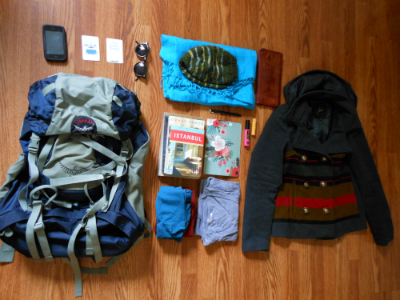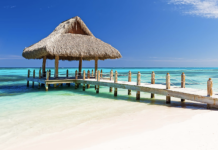Cruising can be fantastic fun for the whole family whatever the weather. With an ever expanding list of exciting destinations accessible via cruise ship plus a constant developing arena in on-board entertainment and conveniences, it is rare you’ll ever hear the phrase “it’s a shame about the weather” on your cruise holiday. Come rain or shine; activities, amusement and exploration are in abundance on modern cruise holidays and providing you are prepared for the climate zone of your choice, you can eliminate any weather woes from spoiling what’s bound to be your best holiday to date.
I’m packed © the opoponax
So you’ve chosen your next port of call, booked your holiday and your famous (yet slightly annoying for anyone not going) holiday countdown has begun. But when it comes to packing, what should you take and how can you ensure a good time is had no matter what the forecast has in store? Take some time to learn a little about the weather zone you are entering and with these handy tips plus some essential pre-planning, you will be well on your way to forecast fortune telling and smooth cruising in no time.
Equatorial
No prizes for guessing these are the countries hugging the equator. If you are cruising to the Equatorial climate you’ll likely be visiting some truly exotic destinations such as Columbia, Brazil and Ecuador in South America, Central America, Central Africa, India, Indonesia and the northern coast of Australia. When cruising along the equator itself you’ll be at zero degrees latitude, the widest point of the earth and exactly between the northern and southern hemispheres. Most countries within the equatorial climate experience just two seasons, wet (tropical rainfall and higher humidity) and dry (cooler temperatures with less rain). Biodiversity is rich here due to the surge in tropical humidity; this also means some of the world’s greatest rainforests are found within this climate zone. If the air feels dense and heavy be prepared for some short but heavy rainfall, plus if you’re cruising during rainy season, air conditioning and onboard entertainment should be high on your check list.
Equatorial Essentials: Rain mac, 50+ sun protection, bug spray, long sleeves, sports socks and closed toe walking shoes or boots for jungle excursions, binoculars, book on wildlife spotting.
Arid
Are you planning a cruise to the Middle East, Australia or Western America? You might find yourself entering an arid climate. Destinations such as (inland) California, Arizona, Texas, Morocco, Egypt, United Arab Emirates, South Africa and Australia can have extremely dry regions and deserts. Although they are astounding in physical appearance, these deserts and their surrounds can be extremely hot and inhospitable places. On the upside, annual rainfall is low and you can experience some beautiful blue skies as descending air and areas of high pressure eliminates the presence of clouds. An arid climate can also bring much colder temperatures as night falls so bare that in mind for evening attire and sleepwear.
Arid Essentials: Water bottle, sun hat for shade, cover ups (choose comfortable materials like cotton and linen), sunglasses, sandals, thermal pyjamas, eye drops, Vaseline.
Mediterranean
Cruising the Mediterranean is a dream come true for most holiday makers, and the balmy Mediterranean climate makes it easy to see why. This climate zone includes countries and regions roughly up to 40 degrees latitude either side of the equator but can also be present slightly further afield. Countries within this climate zone include Portugal, Spain, (the south of) France, Italy, Greece and Turkey but also (far south) Western Australia can experience similar conditions. Due to a seasonal shift in descending air, summers of the Mediterranean climate zone can be warm, sunny and dry with low rainfall. Pleasant and bearable temperatures are generally experienced throughout summer and some of the world’s best beaches are blessed with this weather, but searing heatwaves can also occur so sun protection is still important. Winter will bring cooler temperatures but still shouldn’t be cold enough to warrant packing a bulky overcoat.
Mediterranean Essentials: Swimwear, beach towel, snorkel, waterproof camera, shorts, thin layers, lightweight jacket, walking shoes.
Snow
You may not always see snow when cruising within the snow climate zone but overall temperatures are definitely colder for the most part and summers are short lived. Destinations within this region include Alaska, Canada, Sweden, Finland and Russia. Within this higher northern latitude the winters can be long, harsh and very cold so you’ll want to take some extra thermal layers if you plan on doing some shore exploring outside of the summer months. Frost melting and birds tweeting announce the awakening of spring in some areas and you’ll need good quality hiking boots to explore the magnificent terrains of Alaska, Canada or Sweden. Despite its snow coated stereotype, temperatures can still reach up to 30 degrees in the city of Moscow so consider short sleeves if you’re travelling to Russia’s capital city during summer. Stunning scenery changes drastically from vast thick fir tree forests to baron and empty acres of tundra the further north you explore the snow climate zone.
Snow Essentials: Hat, gloves & scarf for winter, warm (waterproof) coat, lightweight fleece, synthetic fibres (warm in winter, cool in summer), hiking boots, moisturiser, nature or bird spotting book.
Polar
The north and south Polar regions experience different climates but both harbour some of the coldest temperatures in the world. However, those that don’t mind a colder cruise will be rewarded with breath-taking scenery, amazing uninhabited landscapes and some incredible opportune photo moments. Destinations covered by the polar climate zone include (northern) Canada, Greenland, Iceland, Norway, (north and north east) Russia, Antarctica and some areas of western China. The Arctic climate can be more bearable than the south due to moderation from the Atlantic Ocean, meaning that temperatures can reflect those of a mainland European winter. You’ll likely witness frozen ocean and some incredible ice glaciers during a cruise to the arctic north so prepare for the possibility of freezing temperatures. The sky is clear and you’ll want to bring a travel telescope or decent camera for star gazing or chasing the famous northern lights. Wrap up extra warm for a polar cruise to the south because temperatures here have been recorded at -80 Celsius. The air here is drier than most deserts so protect your skin and keep hydrated.
Polar Essentials: Thermal clothes, hiking or snow boots, coat, hat/scarf/gloves/balaclava, digital SLR camera, waterproofs, pocket tissues, torch, polarised wraparound sunglasses, sea sickness medication, swimwear (for natural thermal springs), travel telescope, book on star gazing.
Temperate
Expect a bit of a mixture if you are entering a temperate climate, as this category can include aspects of a Mediterranean, sub-tropical or maritime climate. You could even expect four seasons in one day if you are visiting the UK for example, an island with a typical maritime climate which means conditions are influenced by the ocean. A rain mac, sunglasses and scarf could all be of use during a trip here no matter the time of year. Other destinations experiencing a temperate climate include northern mainland Europe, (western and central) USA, (western) China, (north west) Argentina.
Temperate Essentials: Rain mac, sunglasses, hat, comfy walking shoes, sense of humour, layers, sea sickness medication, guide to cloud spotting
*Climate zones depicted from the Koppen climate classification. Weather conditions are always subject to change and it is advised to check official weather forecasts pre-departure for a happy holiday.







